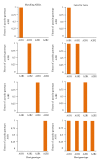What Can Phages Tell Us about Host-Pathogen Coevolution?
- PMID: 23213618
- PMCID: PMC3506893
- DOI: 10.1155/2012/396165
What Can Phages Tell Us about Host-Pathogen Coevolution?
Abstract
The outcomes of host-parasite interactions depend on the coevolutionary forces acting upon them, but because every host-parasite relation is enmeshed in a web of biotic and abiotic interactions across a heterogeneous landscape, host-parasite coevolution has proven difficult to study. Simple laboratory phage-bacteria microcosms can ameliorate this difficulty by allowing controlled, well-replicated experiments with a limited number of interactors. Genetic, population, and life history data obtained from these studies permit a closer examination of the fundamental correlates of host-parasite coevolution. In this paper, I describe the results of phage-bacteria coevolutionary studies and their implications for the study of host-parasite coevolution. Recent experimental studies have confirmed phage-host coevolutionary dynamics in the laboratory and have shown that coevolution can increase parasite virulence, specialization, adaptation, and diversity. Genetically, coevolution frequently proceeds in a manner best described by the Gene for Gene model, typified by arms race dynamics, but certain contexts can result in Red Queen dynamics according to the Matching Alleles model. Although some features appear to apply only to phage-bacteria systems, other results are broadly generalizable and apply to all instances of antagonistic coevolution. With laboratory host-parasite coevolutionary studies, we can better understand the perplexing array of interactions that characterize organismal diversity in the wild.
Figures


Similar articles
-
Impact of bile salts on coevolutionary dynamics between the gut bacterium Escherichia coli and its lytic phage PP01.Infect Genet Evol. 2019 Sep;73:425-432. doi: 10.1016/j.meegid.2019.05.021. Epub 2019 May 30. Infect Genet Evol. 2019. PMID: 31154089
-
The coevolutionary implications of host tolerance.Evolution. 2014 May;68(5):1426-35. doi: 10.1111/evo.12368. Epub 2014 Feb 18. Evolution. 2014. PMID: 24475902
-
Greater Phage Genotypic Diversity Constrains Arms-Race Coevolution.Front Cell Infect Microbiol. 2022 Mar 4;12:834406. doi: 10.3389/fcimb.2022.834406. eCollection 2022. Front Cell Infect Microbiol. 2022. PMID: 35310856 Free PMC article.
-
The role of defensive symbionts in host-parasite coevolution.Biol Rev Camb Philos Soc. 2018 Nov;93(4):1747-1764. doi: 10.1111/brv.12417. Epub 2018 Apr 16. Biol Rev Camb Philos Soc. 2018. PMID: 29663622 Review.
-
Novel genomic approaches to study antagonistic coevolution between hosts and parasites.Mol Ecol. 2021 Aug;30(15):3660-3676. doi: 10.1111/mec.16001. Epub 2021 Jun 22. Mol Ecol. 2021. PMID: 34038012 Review.
Cited by
-
Phage therapy--constraints and possibilities.Ups J Med Sci. 2014 May;119(2):192-8. doi: 10.3109/03009734.2014.902878. Epub 2014 Mar 30. Ups J Med Sci. 2014. PMID: 24678769 Free PMC article. Review.
-
Revenge of the phages: defeating bacterial defences.Nat Rev Microbiol. 2013 Oct;11(10):675-87. doi: 10.1038/nrmicro3096. Epub 2013 Aug 27. Nat Rev Microbiol. 2013. PMID: 23979432 Review.
-
Phage-driven coevolution reveals trade-off between antibiotic and phage resistance in Salmonella anatum.ISME Commun. 2024 Mar 22;4(1):ycae039. doi: 10.1093/ismeco/ycae039. eCollection 2024 Jan. ISME Commun. 2024. PMID: 38616926 Free PMC article.
-
Virus Resistance Is Not Costly in a Marine Alga Evolving under Multiple Environmental Stressors.Viruses. 2017 Mar 8;9(3):39. doi: 10.3390/v9030039. Viruses. 2017. PMID: 28282867 Free PMC article.
-
Phage therapy: Should bacterial resistance to phages be a concern, even in the long run?Bacteriophage. 2013 Jan 1;3(1):e24219. doi: 10.4161/bact.24219. Bacteriophage. 2013. PMID: 23819105 Free PMC article.
References
-
- Arditti J, Elliott J, Kitching IJ, Wasserthal LT. Good heavens what insect can suck it'—Charles Darwin, Angraecum sesquipedale and Xanthopan morganii praedicta . Botanical Journal of the Linnean Society. 169(3):403–432.
-
- Darwin C. On the Various Contrivances by which British and Foreign Orchids Are Fertilised by Insects. London, UK: John Murray; 1862. - PubMed
-
- Kritsky G. Darwin's Madagascan hawk moth prediction. American Entomologist. 1991;37(4):206–210.
-
- Pauw A, Stofberg J, Waterman RJ. Flies and flowers in Darwin’s race. Evolution. 2009;63(1):268–279. - PubMed
-
- Woolhouse MEJ, Webster JP, Domingo E, Charlesworth B, Levin BR. Biological and biomedical implications of the co-evolution of pathogens and their hosts. Nature Genetics. 2002;32(4):569–577. - PubMed
LinkOut - more resources
Full Text Sources

